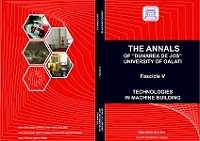ANALYSIS OF THE DISTRIBUTION OF AXIAL FORCE VALUES IN DRILLING, DEPENDING ON MACHINING PARAMETERS
Résumé
Drilling is one of the most widely used material machining processes, with
applications in various industries such as machinery manufacturing, automotive,
and aerospace. One of the factors that influence the quality and efficiency of the
machining process is maintaining a constant cutting force.
Maintaining the cutting force at a constant level during drilling is essential for
ensuring dimensional precision, surface quality, tool durability, operational
efficiency, and safety. Implementing advanced technologies such as automated
control systems and force monitoring can significantly contribute to process
optimization and risk reduction. This ensures high-quality production with reduced
costs and increased productivity.
In this study, the axial force distribution during the drilling of an aluminum
alloy, 2024 T351, was determined, with measurements conducted for three
combinations of machining parameters. A total of 27 holes were machined using
drill bits with diameters of 6, 8, and 10 mm, cutting speeds of 50, 60, and 70 m/min,
and feed rates of 0.1, 0.25, and 0.4 mm/rev.
The axial force measurement was performed using a Kistler dynamometer
available in the Manufacturing Engineering Department of the Faculty of
Engineering at the “Dunărea de Jos” University of Galați.


